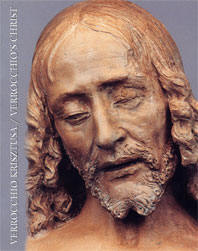
Verrocchio's Christ

Temporary exhibition at the Szépmüvészeti Múzeum,
Budapest
March 13 - June 22, 2003
"The Florentine Andrea del Verocchio
was in his time a master of the goldsmith's art,
perspective, sculpture, intarsia, painting, and
music." The opening words of Vasari's biography of
Verrocchio indicate the multiple talents of the leading
master in the second half of the Quattrocento. Born in
the mid-1430s, Verrocchio established himself as an
independent sculptor and head of a studio by the early
1460s. The inventive and experimental nature of
Verrocchio's sculpture paved the way towards the High
Renaissance, and drew a multitude of assistants to his
shop, including the young Leonardo da Vinci.
The statue of the Man of Sorrows the most important among the many Florentine terracotta statues kept in the Old Sculpture Collection of the Museum of Fine Arts. The story of the statue is known only from 1873. At that time it was exhibited at the Vienna World's Fair as a piece from Ferenc Pulszky's collection. In 1888, the figure of Christ was bought by director Elemér Radisics for the newly formed Museum of Applied Arts in Budapest, and in 1924, Elek Petrovics had the work transferred to the Museum of Fine Arts. |
The statue depicts Christ as the Man of Sorrows, opening His side wound with both hands. With Christ depicted from the knees up, the original arrangement might have included some reference to or depiction of the coffin from which the figure rose. The standing figure reaches for His side wound with the right hand from the bottom and with the left hand from the top, opening the naturalistically depicted wound with the tips of His fingers. The upper body of Christ is entirely bare, His only clothing the loincloth worn at the Crucifixion. This image type, showing Christ as the Man of Sorrows, with the gesture of the opening of the side wound, appeared in Central Europe in the second half of the fourteenth century, and became quite popular at the time of the International Gothic. The only example of this type known from Florence apart from Verrocchio's work is the statue by Dello Delli at the Victoria and Albert Museum, and exhibited here. The statue fits well into the oeuvre of the Verrocchio; an especially close similarity can be observed between this statue and the Christ-figure of the Christ and St. Thomas at Orsanmichele. The new conservation of the statue once again has revealed its very high quality, and it is certain that the piece comes from Verrocchio's workshop and was modelled at least in part by the master himself at the beginning of the 1470s.
The statue was in storage for a long time, and was carefully and completely restored by Ildikó Boros just prior to this exhibition.
 |
One part of the exhibition room will contain works from the circle of Verrocchio, including terracotta and bronze statues, and an altarpiece originally painted for the Florentine church of San Domenico del Maglio. The influence of Verrocchio's inventive statuary will be illustrated by such outstanding works as the statue of the Putto with a dolphin, made by a follower of the master, or by a terracotta bust of Christ on loan from the Victoria & Albert Museum in London. Luca della Robbia's terracotta depicting Christ and St. Thomas will also be exhibited. This statue group was made in 1463 as a competition piece for one of the niches on Orsanmichele, but the commission was eventually given to Verrocchio. |
 |
The other part of the exhibition will present works with the same subject matter as Verrocchio's statue. Panel paintings, among them a work by Fra Filippo Lippi (on loan from the Christian Museum in Esztergom) and masterpieces by Giovanni Santi, Jacopo Montagnana and Giovanni Martino Spanzotti, will illustrate the varieties of this popular image type in the Italian Renaissance. One of the highlights of the show will be a terracotta Man of Sorrows by Dello Delli on loan from the Victoria & Albert Museum, which provides the closest parallel to Verrocchio's statue. The juxtaposition of these two masterpieces will create an unprecedented opportunity to examine how the genius of Verrocchio reworked an older iconographic and compositional type into a form that is his alone. |
Catalogue
 The
exhibition was accompanied by a fully illustrated, bilingual (Hungarian-English)
catalogue, which contains a study on Verrocchio's statue as well as a report on
its restoration.
The
exhibition was accompanied by a fully illustrated, bilingual (Hungarian-English)
catalogue, which contains a study on Verrocchio's statue as well as a report on
its restoration.
The catalogue is still available at the Museum of Fine Arts, or can be purchased online here (in Hungary) or here (abroad).
For further information, contact the exhibition organizer:
Zsombor
Jékely
Old Sculpture Collection
Museum of Fine Arts
Budapest 62. POB. 463
H-1396
Links:
For photos of the exhibition, click here
Szépmüvészeti Múzeum (Museum of Fine Arts), Budapest
Works of Verrocchio (Web Gallery of Art)
Victoria and Albert Museum, London
--Last updated: March 13, 2002--
© 2002 by Zsombor Jékely